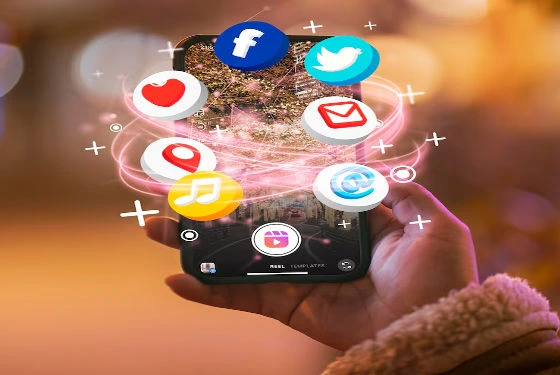As we move through 2025, social media has evolved beyond mere platforms for connectivity, becoming the backbone of entertainment, commerce, and brand engagement. This transformation is powered by AI-driven algorithms, increasingly personalized consumer experiences, and shifting marketing trends that reflect how audiences now consume and engage with content.
This article explores:
The mechanics of social media algorithms in 2025.
Marketing trends that are defining this year.
Strategic insights for brands to thrive in this dynamic landscape.
I. How Social Media Algorithms Work in 2025
1. AI and Deep Learning at the Core
In 2025, social media marketing management algorithms leverage AI—not only machine learning but deep learning and reinforcement models—to interpret and predict user behavior. Platforms analyze signals across likes, swipe behavior, dwell time, and more to tailor the feed in real time.
Sprinklr highlights that these algorithms form a continuous feedback loop: user actions inform future recommendations, driving visibility and engagement.
2. Explosion of Data and Cross-Platform Integration
Data fueling algorithms has grown astronomically. From generating 2 zettabytes annually a little over a decade ago, the figure is expected to reach 181 zettabytes in 2025.
Moreover, algorithms are not limited to in-app behavior—they tap into GPS data, device info, browsing habits, and cross-application engagement to deliver hyper-personalized content feeds
3. Beyond Likes: Quality, Intent & Cross-format Journeys
Algorithms no longer just rank by likes or shares. They prioritize:
Engagement quality
User intent cues (e.g., watch time, comment sentiment)
Cross-format journeys (e.g., moving from a short video to a full tutorial).
4. Platform-Specific Nuances
Each platform has distinct mechanisms:
Instagram: Separate algorithms for Feed, Explore, Reels—Reels and original content get prioritized, especially shorter ones.
Facebook: AI predicts what content will spark meaningful interactions and estimates engagement likelihood via relevancy scores.
YouTube: In July 2025, YouTube discontinued its universal Trending page, shifting toward AI-powered discovery, category-specific charts, and personalized Explore tabs.
5. The Black-Box Conundrum & Real-Time Testing
Platforms run continuous A/B testing, tweaking the algorithm in real time to optimize engagement, yet transparency remains limited. This black-box nature requires brands to be agile, data-savvy, and responsive.
II. Social Media Marketing Trends Shaping 2025
1. Content Experimentation
a. Creative Disruption
Brands are intentionally breaking away from consistent branding to experiment creatively. Entertainment now dominates: over 60% of social content aims to entertain, educate, or inform, with up to 100% entertainment-driven content in a quarter of organizations.
b. Outbound Engagement
Proactive engagement—like brands jumping into creator comments—boosts reach. Stats show a 1.6× increase in engagement when brands reply to user comments.
2. Social Listening & Micro-Virality
a. Social Performance via Listening
Social listening tools are now strategic assets. 62% of social marketers use them, making listening the second-highest priority after direct audience engagement. These tools have elevated social teams to performance marketing status by delivering actionable, revenue-linked insights.
b. The Shift from Mass Virality to Micro-Virality
Brands are moving away from chasing mainstream going-viral moments. Instead, they focus on audience-focused virality, informed by real-time trend analysis and sentiment monitoring.
3. Generative AI Integration
a. AI-as-a-Teammate
Generative AI is now mainstream. 69% of marketers view AI as revolutionary, and its utility in content creation has surged.
b. Hybrid Human-AI Workflows
AI handles repetitive tasks (e.g., hashtag suggestions, video editing), while humans add strategic creativity and brand authenticity. This hybrid approach is vital for maintaining both efficiency and uniqueness
4. AI-Powered Personalization & Emotional Targeting
a. Real-Time Personalization
AI and personalization engines analyze consumer behavior in real time to tailor marketing communications. Despite insights being valuable, challenges in data governance and organizational skills remain.
b. Emotional Resonance & Neuromarketing
AI isn’t just tracking behavior—it’s measuring emotional engagement. Brands leverage AI to capture emotions like nostalgia or surprise, intensifying ad memory and consumer attachment.
5. Shoppable Social & Video Commerce
Platforms now support in-app purchases, shoppable posts, and seamless checkouts. This social commerce trend is booming, especially in video-first contexts like TikTok Shop and Instagram Shopping.
In Europe, video-based affiliate marketing is growing rapidly—supported by performance-based models like CPS and enhanced attribution systems.
6. Rise & Evolution of the Creator Economy
The creator economy is now a $500 billion industry, with over 50 million global influencers. While algorithm changes challenge visibility, creators are adapting via affiliate marketing, micro/nano-influencers, and even equity deals—strengthening brand partnerships.
7. Meme Marketing & AI-Enabled Content
Memes are now integral to campaigns. AI tools like GPT generators create on-demand memes, though authenticity remains a major risk if humor falls flat. Still, meme marketing is expected to grow as a universal, visually rich brand language.
III. Strategic Insights: What Brands Must Do in 2025
1. Embrace Agile Creativity
Let go of rigid branding to experiment with format, tone, and voice—especially in social content aimed at entertaining.
2. Prioritize Social Listening
Use listening tools to understand sentiment, surface market gaps, and respond to trends with precision. This builds credibility and ROI evidence.
3. Leverage AI—Responsibly
Deploy AI for scale, but maintain human touch:
Use hybrid workflows.
Ensure emotional resonance via neuromarketing insights.
Stay transparent and ethical with AI use.
4. Optimize for Shoppable and Video Commerce
Plugins for checkout, live streams, and video content are direct revenue channels. Integrate them for frictionless brand interactions.
5. Partner with Creators Judiciously
Focus on authentic micro-influencers. Use affiliate and membership-based models for performance transparency and deeper engagement.
6. Leverage Memes & Cultural Relevance
AI-assisted memes offer cultural resonance, but human oversight is essential to avoid misfires.
7. Adapt to Algorithm Realities
Analyze platform-specific signals.
Test and adapt strategies rapidly.
Understand that automated personalization dominates and ephemeral virality requires agile response.
IV. Looking Ahead: What’s Next Beyond 2025
1. Immersive AI-Curated Environments
The 2030s will likely usher in 3D, metaverse-inspired social platforms, with AI “companion influencers,” emotional-first recommendation systems, and avatar-based interaction.
2. Decentralized Platforms & Governance
Users may gravitate toward platforms that offer greater control—like Web3-based or decentralized models (e.g., Bluesky, Lens)—reshaping content ownership and monetization mechanisms.
3. Regulatory & Ethical Imperatives
As platforms and AI systems scale, transparency, AI ethics, and regulations (e.g., EU AI Act) will become vital in maintaining trust and legitimacy in marketing and content distribution.
Conclusion
2025 is the year that social media became undeniably AI-first, commerce-centric, and creativity-driven. To succeed, brands must pivot from rigid strategies to data-smart, audience-aware, emotionally intelligent, and algorithm-savvy approaches.
From mastering platform-specific algorithms and hybrid AI workflows to embracing social commerce, micro-virality, and creator partnerships—this new era rewards flexibility, empathy, and innovation.
Let me know if you’d like to drill deeper into any of these topics—like platform-specific tactics, campaign case studies, or AI tools for social marketing.



